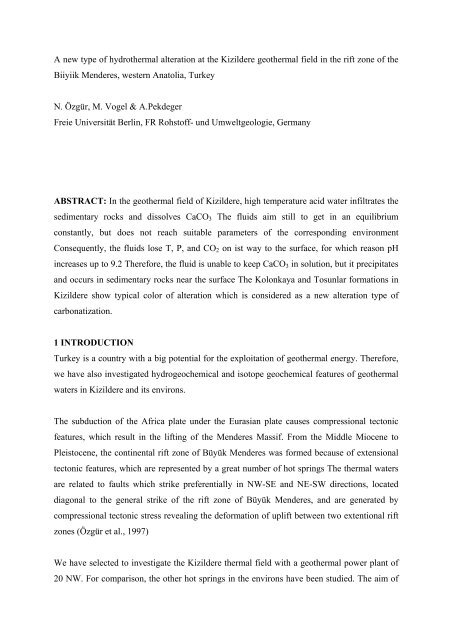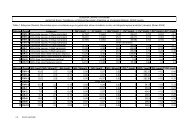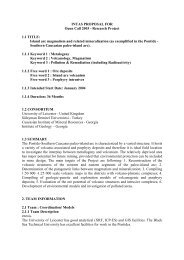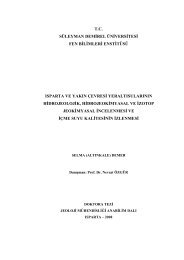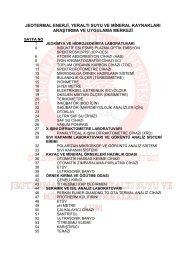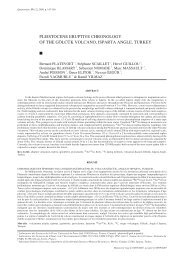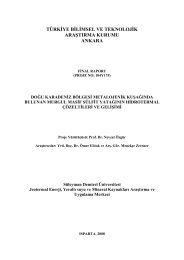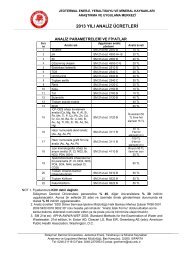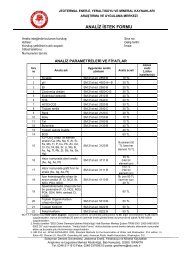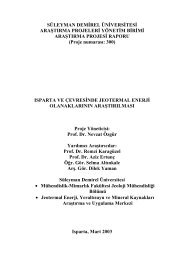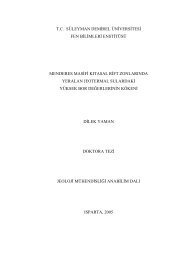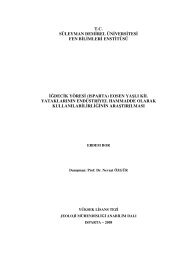A new type of hydrothermal alteration at the Kizildere geothermal ...
A new type of hydrothermal alteration at the Kizildere geothermal ...
A new type of hydrothermal alteration at the Kizildere geothermal ...
Create successful ePaper yourself
Turn your PDF publications into a flip-book with our unique Google optimized e-Paper software.
A <strong>new</strong> <strong>type</strong> <strong>of</strong> <strong>hydro<strong>the</strong>rmal</strong> <strong>alter<strong>at</strong>ion</strong> <strong>at</strong> <strong>the</strong> <strong>Kizildere</strong> geo<strong>the</strong>rmal field in <strong>the</strong> rift zone <strong>of</strong> <strong>the</strong><br />
Biiyiik Menderes, western An<strong>at</strong>olia, Turkey<br />
N. Özgür, M. Vogel & A.Pekdeger<br />
Freie Universität Berlin, FR Rohst<strong>of</strong>f- und Umweltgeologie, Germany<br />
ABSTRACT: In <strong>the</strong> geo<strong>the</strong>rmal field <strong>of</strong> <strong>Kizildere</strong>, high temper<strong>at</strong>ure acid w<strong>at</strong>er infiltr<strong>at</strong>es <strong>the</strong><br />
sedimentary rocks and dissolves CaCO 3 The fluids aim still to get in an equilibrium<br />
constantly, but does not reach suitable parameters <strong>of</strong> <strong>the</strong> corresponding environment<br />
Consequently, <strong>the</strong> fluids lose T, P, and CO 2 on ist way to <strong>the</strong> surface, for which reason pH<br />
increases up to 9.2 Therefore, <strong>the</strong> fluid is unable to keep CaCO 3 in solution, but it precipit<strong>at</strong>es<br />
and occurs in sedimentary rocks near <strong>the</strong> surface The Kolonkaya and Tosunlar form<strong>at</strong>ions in<br />
<strong>Kizildere</strong> show typical color <strong>of</strong> <strong>alter<strong>at</strong>ion</strong> which is considered as a <strong>new</strong> <strong>alter<strong>at</strong>ion</strong> <strong>type</strong> <strong>of</strong><br />
carbon<strong>at</strong>iz<strong>at</strong>ion.<br />
1 INTRODUCTION<br />
Turkey is a country with a big potential for <strong>the</strong> exploit<strong>at</strong>ion <strong>of</strong> geo<strong>the</strong>rmal energy. Therefore,<br />
we have also investig<strong>at</strong>ed hydrogeochemical and isotope geochemical fe<strong>at</strong>ures <strong>of</strong> geo<strong>the</strong>rmal<br />
w<strong>at</strong>ers in <strong>Kizildere</strong> and its environs.<br />
The subduction <strong>of</strong> <strong>the</strong> Africa pl<strong>at</strong>e under <strong>the</strong> Eurasian pl<strong>at</strong>e causes compressional tectonic<br />
fe<strong>at</strong>ures, which result in <strong>the</strong> lifting <strong>of</strong> <strong>the</strong> Menderes Massif. From <strong>the</strong> Middle Miocene to<br />
Pleistocene, <strong>the</strong> continental rift zone <strong>of</strong> Büyük Menderes was formed because <strong>of</strong> extensional<br />
tectonic fe<strong>at</strong>ures, which are represented by a gre<strong>at</strong> number <strong>of</strong> hot springs The <strong>the</strong>rmal w<strong>at</strong>ers<br />
are rel<strong>at</strong>ed to faults which strike preferentially in NW-SE and NE-SW directions, loc<strong>at</strong>ed<br />
diagonal to <strong>the</strong> general strike <strong>of</strong> <strong>the</strong> rift zone <strong>of</strong> Büyük Menderes, and are gener<strong>at</strong>ed by<br />
compressional tectonic stress revealing <strong>the</strong> deform<strong>at</strong>ion <strong>of</strong> uplift between two extentional rift<br />
zones (Özgür et al., 1997)<br />
We have selected to investig<strong>at</strong>e <strong>the</strong> <strong>Kizildere</strong> <strong>the</strong>rmal field with a geo<strong>the</strong>rmal power plant <strong>of</strong><br />
20 NW. For comparison, <strong>the</strong> o<strong>the</strong>r hot springs in <strong>the</strong> environs have been studied. The aim <strong>of</strong>
this paper to present a <strong>new</strong> <strong>type</strong> <strong>of</strong> <strong>hydro<strong>the</strong>rmal</strong> <strong>alter<strong>at</strong>ion</strong> <strong>of</strong> carbon<strong>at</strong>iz<strong>at</strong>ion in <strong>the</strong><br />
geo<strong>the</strong>rmal field <strong>of</strong> <strong>Kizildere</strong> and hydrogeochemical fe<strong>at</strong>ures <strong>of</strong> <strong>the</strong> <strong>the</strong>rmal w<strong>at</strong>ers in<br />
combin<strong>at</strong>ion with <strong>the</strong> origin and evolution <strong>of</strong> <strong>the</strong> <strong>the</strong>rmal w<strong>at</strong>ers.<br />
A research scheme was carried out in 1993/1995, divided into two main fields:<br />
(i) geological and geochemical investig<strong>at</strong>ions based on detailed geological mapping and rock<br />
sampling and (ii) comprehensive hydrogeological and hydrogeochemical investig<strong>at</strong>ions with<br />
sampling <strong>of</strong> groundw<strong>at</strong>er and <strong>the</strong>rmal w<strong>at</strong>ers.<br />
2 GEOLOGIC SETTING<br />
The <strong>Kizildere</strong> geo<strong>the</strong>rmal field is loc<strong>at</strong>ed in <strong>the</strong> nor<strong>the</strong>rn part <strong>of</strong> <strong>the</strong> Büyük Menderes rift<br />
zone, which represents an important tectonic structure <strong>of</strong> Qu<strong>at</strong>ernary age within <strong>the</strong> Menderes<br />
Massif (Fig. 1). The Massif is one <strong>of</strong> <strong>the</strong> oldest basements in Turkey and consists <strong>of</strong> (i) a<br />
gneiss-core surrounded by a schist and marble envelope, (ii) a less metamorphosed cover<br />
series and (iii) an intensely deformed volcano sedimentary sequence with incipient HP/LT<br />
metamorphism. The rift zones within <strong>the</strong> massif are <strong>the</strong> results <strong>of</strong> an extension which is<br />
believed to be closely rel<strong>at</strong>ed to <strong>the</strong> northward movement <strong>of</strong> <strong>the</strong> Arabian pl<strong>at</strong>e in <strong>the</strong> east<br />
pushing An<strong>at</strong>olia westwards through <strong>the</strong> North An<strong>at</strong>olian and East An<strong>at</strong>olian Faults. The<br />
sou<strong>the</strong>rly bending <strong>of</strong> <strong>the</strong> North An<strong>at</strong>olian Fault in <strong>the</strong> nor<strong>the</strong>rn Aegean and Greece prevents<br />
<strong>the</strong> escape <strong>of</strong> <strong>the</strong> An<strong>at</strong>olian pl<strong>at</strong>e fur<strong>the</strong>r westwards placing <strong>the</strong> system in a locking geometry<br />
(Dewey & Sengör, 1979). This cre<strong>at</strong>es an E-W compression in <strong>the</strong> Menderes Massif which is<br />
relieved by N-S extension. The driving force <strong>of</strong> extension in <strong>the</strong> Aegean is believed to be <strong>the</strong><br />
subduction along <strong>the</strong> Hellenic Trench (McKenzie, 1978). For <strong>the</strong> timing <strong>of</strong> initi<strong>at</strong>ion <strong>of</strong><br />
extension an age within a range from 26 Ma (Spakman, 1989) about 12 Ma (Le Pichon &<br />
Angelier, 1979) to 5 Ma (P<strong>at</strong>ton, 1992) is given. In <strong>the</strong> <strong>the</strong>rmal field <strong>of</strong> <strong>Kizildere</strong>, <strong>the</strong><br />
basement is comprised by <strong>the</strong> Paleozoic metamorphics which consist <strong>of</strong> gneiss, schist and <strong>the</strong><br />
igdecik form<strong>at</strong>ion with intercal<strong>at</strong>ions <strong>of</strong> quartzites, mica schists, and marbles (Simsek, 1985;<br />
Vogel, 1997).<br />
The basement rocks are overlain by Pliocene sediments These sediments show fluvial and<br />
lacustrine characters and consist <strong>of</strong> (i) <strong>the</strong> 200-m-thick Kizilburun form<strong>at</strong>ion, (ii) <strong>the</strong> Sazak<br />
form<strong>at</strong>ion with a thickness from 100 to 250 m, (iii) <strong>the</strong> Kolonkaya form<strong>at</strong>ion in a range <strong>of</strong><br />
thickness from 350 to 500 m, and (iv) <strong>the</strong> 500-m-thick Tosunlar form<strong>at</strong>ion. The Kizilburun<br />
form<strong>at</strong>ion is an intercal<strong>at</strong>ion <strong>of</strong> red and brown conglomer<strong>at</strong>es, sandstones, shales, and
lignites, <strong>the</strong> Sazak form<strong>at</strong>ion is composed <strong>of</strong> intercal<strong>at</strong>ed grey limestones, marls, and<br />
siltstones. The Kolonkaya form<strong>at</strong>ion contains yellowish green marls, siltstones, and<br />
sandstones, <strong>the</strong> Tosunlar form<strong>at</strong>ion is composed <strong>of</strong> an altern<strong>at</strong>ion <strong>of</strong> conglomer<strong>at</strong>es,<br />
sandstones and mudstones with fossiliferous clay units. Qu<strong>at</strong>ernary alluvium overlies all <strong>of</strong><br />
<strong>the</strong> units and reaches a maximum thickness <strong>of</strong> some hundred meters.<br />
Fig. 1 Geologic setting <strong>of</strong> <strong>the</strong> Menderes Massif and loc<strong>at</strong>ion map <strong>of</strong> <strong>the</strong> geo<strong>the</strong>rmal field <strong>of</strong><br />
<strong>Kizildere</strong> (open triangle <strong>the</strong> geo<strong>the</strong>rmal field <strong>of</strong> <strong>Kizildere</strong>; closed triangles o<strong>the</strong>r geo<strong>the</strong>rmal<br />
fields).<br />
The <strong>the</strong>rmal field is regionally controlled by E-W trending faults. Locally, NW-SE or NE-SW<br />
trending faults are active in <strong>the</strong> field. The development <strong>of</strong> <strong>the</strong>se trending faults lead to a<br />
compression, which was gener<strong>at</strong>ed by <strong>the</strong> extension during <strong>the</strong> form<strong>at</strong>ion <strong>of</strong> <strong>the</strong> rift zone <strong>of</strong><br />
Büyük Menderes (Özgür et al., 1997). The nor<strong>the</strong>rn and sou<strong>the</strong>rn flanks <strong>of</strong> <strong>the</strong> metamorphic<br />
basement are affected by uplifting and dissected into a gre<strong>at</strong> number <strong>of</strong> step faults.<br />
3 HYDROTHERMAL ALTERATION<br />
In <strong>the</strong> geo<strong>the</strong>rmal field <strong>of</strong> <strong>Kizildere</strong>, <strong>the</strong> metamorphic and sedimentary rocks are distinguished<br />
by intensely <strong>hydro<strong>the</strong>rmal</strong> <strong>alter<strong>at</strong>ion</strong>. Besides phyllic, argillic and silicic <strong>alter<strong>at</strong>ion</strong><br />
±haem<strong>at</strong>itiz<strong>at</strong>ion, a <strong>new</strong> <strong>alter<strong>at</strong>ion</strong> <strong>type</strong> <strong>of</strong> carbon<strong>at</strong>iz<strong>at</strong>ion is recognized in sedimentary rocks<br />
especially. Silicific<strong>at</strong>ion ±haem<strong>at</strong>itiz<strong>at</strong>ion is an additional overprinting <strong>type</strong> <strong>of</strong> <strong>alter<strong>at</strong>ion</strong> and<br />
does not depend upon <strong>the</strong> rock chemistry. A noticeable result <strong>of</strong> silicific<strong>at</strong>ion is <strong>the</strong> increase<br />
<strong>of</strong> density and hardness. Hydro<strong>the</strong>rmal fluids will be able to precipit<strong>at</strong>e quartz with haem<strong>at</strong>ite<br />
in veins, and/or hollows in all kind <strong>of</strong> rocks.<br />
The precondition for <strong>the</strong> form<strong>at</strong>ion <strong>of</strong> phyllic and argillic <strong>alter<strong>at</strong>ion</strong> is <strong>the</strong> presence <strong>of</strong> feldspar
ocks. The metamorphic rocks show potassium metasom<strong>at</strong>ism and plagioclase. Over a wide<br />
area, white clay minerals, such as montmorillonite and kaolinite and fine-grainec micas as<br />
sericite and illite, displace K-feldspar and biotite by hydrolysis. In <strong>the</strong>se metasom<strong>at</strong>ic<br />
reactions hydrogen ions will be consumed while pot will be released. The macroscopic effect<br />
is a powdery texture <strong>of</strong> <strong>the</strong> involved rocks, which loses its texture.<br />
The Pliocene sedimentary rocks <strong>of</strong> <strong>the</strong> <strong>Kizildere</strong> geo<strong>the</strong>rmal field show already from distance<br />
intense coloured zones. Near <strong>the</strong> surface, <strong>the</strong> marls and limestones <strong>of</strong> <strong>the</strong> Kolonkaya and<br />
Tosunlar form<strong>at</strong>ions vary from pale white to yellow, orange and brown to dark red colored<br />
shapes. Responsible for <strong>the</strong> colors are iron mineraliz<strong>at</strong>ions, but <strong>the</strong> fading is a result <strong>of</strong> <strong>the</strong><br />
phenomena <strong>of</strong> carbon<strong>at</strong>iz<strong>at</strong>ion (fig. 2). By <strong>the</strong> process <strong>of</strong> <strong>hydro<strong>the</strong>rmal</strong> <strong>alter<strong>at</strong>ion</strong> Ca2+ is<br />
usually heavily depleted except by <strong>the</strong> <strong>type</strong> carbon<strong>at</strong>iz<strong>at</strong>ion (Meyer & Hemley, 1967).<br />
Fig. 2 Soil carbon<strong>at</strong>iz<strong>at</strong>ion by <strong>the</strong> infiltr<strong>at</strong>ion <strong>of</strong> high temper<strong>at</strong>ure acid w<strong>at</strong>er in marls and<br />
limestones <strong>of</strong> <strong>the</strong> Kolonkaya form<strong>at</strong>ion in <strong>Kizildere</strong> (Scale: 1:100).<br />
In this process, <strong>the</strong> carbonic acid in geo<strong>the</strong>rmal w<strong>at</strong>ers determines whe<strong>the</strong>r <strong>the</strong>se w<strong>at</strong>ers will<br />
dissolve carbon<strong>at</strong>es (limestones and marls) or precipit<strong>at</strong>e <strong>the</strong>m as follows:<br />
ersion<br />
CaCO 3 + H 2 CO 3 ↔ Ca 2+ -<br />
+ 2HCO 3<br />
Solid solution deposition solution solutior<br />
In contrast to o<strong>the</strong>r <strong>type</strong>s <strong>of</strong> <strong>hydro<strong>the</strong>rmal</strong> <strong>alter<strong>at</strong>ion</strong>, it is a form<strong>at</strong>ion <strong>of</strong> carbon<strong>at</strong>e assemblage<br />
by introduction <strong>of</strong> C0 2- 3 which is able to fix metal ions such as Mg 2+ , Fe 3+ , Ca 2+ and Mn 2+ .<br />
Therefore, many different kind <strong>of</strong> carbon<strong>at</strong>iz<strong>at</strong>ion can be discrimin<strong>at</strong>ed.. Dolomitiz<strong>at</strong>ion <strong>of</strong><br />
limestones by magnesium metasom<strong>at</strong>ism is a simple base-exchange process and one <strong>of</strong> <strong>the</strong>m.<br />
Two or more different <strong>type</strong>s <strong>of</strong> carbon<strong>at</strong>es can occur in <strong>the</strong> same <strong>alter<strong>at</strong>ion</strong> zone depending on
<strong>the</strong> chemical composition <strong>of</strong> <strong>the</strong> rocks and <strong>the</strong> solutions. In <strong>the</strong> investig<strong>at</strong>ed area <strong>of</strong> <strong>Kizildere</strong>,<br />
it seems to be obvious th<strong>at</strong> <strong>the</strong> carbon<strong>at</strong>e is dissolved in one place and precipit<strong>at</strong>ed <strong>at</strong> ano<strong>the</strong>r<br />
by <strong>hydro<strong>the</strong>rmal</strong> solutions. This can be explained by <strong>the</strong> changes <strong>of</strong> physicochemical<br />
parameters <strong>of</strong> <strong>hydro<strong>the</strong>rmal</strong> fluids.<br />
In general, strongly altered rocks occur along <strong>the</strong> tectonicaly weakened zones because <strong>of</strong> <strong>the</strong><br />
better possibility <strong>of</strong> intense <strong>hydro<strong>the</strong>rmal</strong> w<strong>at</strong>er rock interaction. In spite <strong>of</strong> this <strong>the</strong> domain <strong>of</strong><br />
<strong>hydro<strong>the</strong>rmal</strong> carbon<strong>at</strong>iz<strong>at</strong>ion shows <strong>the</strong> gre<strong>at</strong>est horizontal extension in <strong>the</strong> investig<strong>at</strong>ed area.<br />
For <strong>the</strong> form<strong>at</strong>ion <strong>of</strong> an <strong>alter<strong>at</strong>ion</strong> <strong>type</strong> <strong>of</strong> carbon<strong>at</strong>iz<strong>at</strong>ion, an immedi<strong>at</strong>e contact with high<br />
temper<strong>at</strong>ure <strong>the</strong>rmal w<strong>at</strong>ers is not necessary.<br />
4 GEOCHEMISTRY<br />
Within <strong>the</strong> present study, <strong>the</strong> outflow <strong>of</strong> 10 <strong>the</strong>rmal springs, 8 drill holes, I groundw<strong>at</strong>er<br />
spring were sampled in different seasons from 1992 to 1995. For hydrogeochemical and<br />
isotopic comparison, we have taken a rain w<strong>at</strong>er sample from <strong>the</strong> geo<strong>the</strong>rmal area <strong>of</strong><br />
<strong>Kizildere</strong>. Additionally, 120 rock samples and 48 precipit<strong>at</strong>ions were collected in <strong>the</strong><br />
investig<strong>at</strong>ed area. At <strong>the</strong> surface, <strong>the</strong> metamorphic and sedimentary rocks are distinguished by<br />
an enrichment <strong>of</strong> <strong>the</strong> metals <strong>of</strong> Hg, Sb, As, Tl, and Ag in connection with <strong>the</strong> intensity <strong>of</strong><br />
<strong>hydro<strong>the</strong>rmal</strong> <strong>alter<strong>at</strong>ion</strong> which geochemically can be compared with <strong>the</strong> fields <strong>of</strong> epi<strong>the</strong>rmal<br />
ore deposits (Özgür et al., 1997).<br />
Generally, Hg values are high in <strong>the</strong> less altered metamorphic and sedimentary rocks. The<br />
rocks <strong>of</strong> Igdecik, Sazak and Kolonkaya form<strong>at</strong>ions show extremely high Hg values, between<br />
800 and 865 ppm, which might be <strong>at</strong>tributed to <strong>the</strong> geo<strong>the</strong>rmal activity in <strong>the</strong> investig<strong>at</strong>ed<br />
area. The Tosunlar form<strong>at</strong>ion and travertine have Hg values ranging from 1.0 to 1.3 ppm. The<br />
less altered metamorphic and sedimentary rocks show Sb values from 0.2 to 1.0 ppm. Besides<br />
<strong>the</strong> Sb values up to 39 ppm in travertine, <strong>the</strong> Sazak form<strong>at</strong>ion, as a reservoir rock, shows <strong>the</strong><br />
highest Sb concentr<strong>at</strong>ions up to 106 ppm which might be also <strong>at</strong>tributed to <strong>hydro<strong>the</strong>rmal</strong><br />
activity. The less altered metamorphic rocks are distinguished by As contents <strong>of</strong> 1.0 ppm. The<br />
rocks <strong>of</strong> Kizilburun, Sazak and Tosunlar form<strong>at</strong>ions show As concentr<strong>at</strong>ions <strong>of</strong> about 100<br />
ppm. The Kolonkaya form<strong>at</strong>ion reaches As values <strong>of</strong> 265 ppm. Travertine has As contents up<br />
to 420 ppm. The high As concentr<strong>at</strong>ions in <strong>the</strong> altered sedimentary rocks are linked to <strong>the</strong><br />
<strong>hydro<strong>the</strong>rmal</strong> activity. High boron contents, up to 900 ppm, are found in gneiss which can be<br />
led to <strong>the</strong> mineral phases <strong>of</strong> tourmaline and biotite. In <strong>the</strong> sedimentary form<strong>at</strong>ions, <strong>the</strong>re are B
contents ranging from 2 to 20 ppm, but up to 680 ppm in <strong>the</strong> Kolonkaya form<strong>at</strong>ion and 2850<br />
ppm in travertine. Moreover, <strong>the</strong> high concentr<strong>at</strong>ions <strong>of</strong> B might be <strong>at</strong>tributed to a B deposit <strong>at</strong><br />
depth in sedimentary rocks. Fluorine shows values up to 1000 ppm in gneiss and up to 2125<br />
in <strong>the</strong> sedimentary rocks and travertine which may be <strong>at</strong>tributed to a <strong>hydro<strong>the</strong>rmal</strong> activity.<br />
The surface temper<strong>at</strong>ures <strong>of</strong> <strong>the</strong> <strong>Kizildere</strong> <strong>the</strong>rmal w<strong>at</strong>ers in drill holes differ from 95 to 100<br />
°C whereas <strong>the</strong> outflows <strong>of</strong> 10 <strong>the</strong>rmal springs in <strong>the</strong> surrounding area show temper<strong>at</strong>ures<br />
from 40 to 73 °C. In <strong>the</strong> <strong>the</strong>rmal field <strong>of</strong> <strong>Kizildere</strong>, <strong>the</strong> geochemical <strong>the</strong>rmometers indic<strong>at</strong>e a<br />
reservoir temper<strong>at</strong>ure <strong>of</strong> 220-230 °C (Na-K), 230-260 °C (Na-K-Ca), and 260 °C (SiO 2 ). The<br />
<strong>Kizildere</strong> <strong>the</strong>rmal w<strong>at</strong>ers are distinguished by pH values <strong>of</strong> 9.2, an Eh value <strong>of</strong> -150 mV, a<br />
mean value <strong>of</strong> conductivity <strong>of</strong> 5300 µS/cm, and total dissolved solids (TDS) <strong>of</strong> 4500 mg/l. In<br />
comparison, <strong>the</strong> w<strong>at</strong>ers in <strong>the</strong> vicinity have pH values from 6.1 to 7.1, Eh values in a range<br />
from -137 to 311 mV, conductivity values from 2360 to 3660 µS/cm, and TDS from 1780 to<br />
3838 mg/l.<br />
Hydrogeochemically, <strong>the</strong> <strong>the</strong>rmal w<strong>at</strong>ers <strong>of</strong> <strong>Kizildere</strong> and its environs can be classified as Na-<br />
(SO 4 )-HCO 3 -<strong>type</strong>, during <strong>the</strong> w<strong>at</strong>ers <strong>of</strong> Pamukkale and Karahayit show Ca-Na-(SO 4 )-HCO 3 -<br />
<strong>type</strong> (Fig. 3). This can be explained by mixing <strong>of</strong> a <strong>the</strong>rmal sodium bicarbon<strong>at</strong>e component, a<br />
cold calcium sulf<strong>at</strong>e component and a cold calcium bicarbon<strong>at</strong>e component in different<br />
proportions (Guidi et al., 1990); altern<strong>at</strong>ively, <strong>the</strong> sodium bicarbon<strong>at</strong>e <strong>the</strong>rmal w<strong>at</strong>er could<br />
dissolve calcium sulf<strong>at</strong>e from <strong>the</strong> Neogene sediments and mix with cold calcium bicarbon<strong>at</strong>e<br />
w<strong>at</strong>er to origin<strong>at</strong>e <strong>the</strong>se intermedi<strong>at</strong>e w<strong>at</strong>ers. The shallow w<strong>at</strong>ers, loc<strong>at</strong>ed near <strong>the</strong> village <strong>of</strong><br />
<strong>Kizildere</strong>, exhibit sodium magnesium sulf<strong>at</strong>e compositions and TDS <strong>of</strong> 244 mg/1.<br />
Fig. 3 Thermal w<strong>at</strong>ers <strong>of</strong> <strong>Kizildere</strong> and its environs on a PIPER diagram.
The genetic mechanism <strong>of</strong> <strong>the</strong>se w<strong>at</strong>ers implies <strong>the</strong> infiltr<strong>at</strong>ion <strong>of</strong> sodium bicarbon<strong>at</strong>e <strong>the</strong>rmal<br />
w<strong>at</strong>ers into shallow environments where leaching <strong>of</strong> Neogene sedimentary rocks and calcium<br />
carbon<strong>at</strong>e precipit<strong>at</strong>ion takes place. Trace elements which indic<strong>at</strong>e intensive high temper<strong>at</strong>ure<br />
w<strong>at</strong>er-rock interaction such as B (35 mg/l) and F (35 mg/l) are found in high concentr<strong>at</strong>ions in<br />
<strong>the</strong>se w<strong>at</strong>ers (Özgür et al., 1997). As heavy metals, <strong>the</strong>re are high concentr<strong>at</strong>ions <strong>of</strong> As (1<br />
mg/l) and Sb (0.1 mg/l) in <strong>the</strong> w<strong>at</strong>ers <strong>of</strong> <strong>Kizildere</strong>. The contents <strong>of</strong> Au and Ag toge<strong>the</strong>r with<br />
base metals (Cu, Pb, Zn) lie under <strong>the</strong> detection limits, which could be probably precipit<strong>at</strong>ed<br />
in deep environments under suitable pH, Eh and temper<strong>at</strong>ure conditions.<br />
5 CONCLUSIONS<br />
Due to high temper<strong>at</strong>ure, pressure, and high content <strong>of</strong> CO 2 in <strong>the</strong> <strong>the</strong>rmal w<strong>at</strong>ers <strong>of</strong> <strong>Kizildere</strong>,<br />
high temper<strong>at</strong>ure acid w<strong>at</strong>er infiltr<strong>at</strong>es <strong>the</strong> soil form<strong>at</strong>ions and dissolves CaCO 3 . The solution<br />
aims to get in an equilibrium constantly, but does not reach <strong>the</strong> suitable parameters <strong>of</strong> <strong>the</strong><br />
corresponding environment. Thus, <strong>the</strong> solution loses temper<strong>at</strong>ure, pressure and (CO 2 ) gas on<br />
its way to <strong>the</strong> surface, for which reason <strong>the</strong> pH values increase up to pH 9,2 Consequently, <strong>the</strong><br />
geo<strong>the</strong>rmal fluid is unable to keep CaCO 3 in solution, but it precipit<strong>at</strong>es and occurs in <strong>the</strong><br />
sedimentary rocks near <strong>the</strong> surface Especially in <strong>the</strong> S and SE <strong>of</strong> <strong>the</strong> <strong>Kizildere</strong> geo<strong>the</strong>rmal<br />
field, <strong>the</strong> marls and limestones <strong>of</strong> <strong>the</strong> Pliocene Kolonkaya and Tosunlar form<strong>at</strong>ions show<br />
typical values in color and structure which can be considered as an <strong>alter<strong>at</strong>ion</strong> <strong>type</strong> <strong>of</strong><br />
carbon<strong>at</strong>iz<strong>at</strong>ion.<br />
6 REFERENCES<br />
Dewey, J.F. & A.M.C. Sengör, 1979. Aegean and surrounding regions: complex multipl<strong>at</strong>e and<br />
continuum tectonics in a convergent zone. Geol. Soc. Am. Bull. Part I, 90: 84-92.<br />
Guidi, M., L. Marini, & C. Principe, 990. Hydrogeochemistry <strong>of</strong> <strong>Kizildere</strong> geo<strong>the</strong>rmal system and<br />
nearby region. Geo<strong>the</strong>rmal Resources Council Transactions, Vol. 14, Part II; 901-908.<br />
Le Pichon, X. & J. Angelier, 1979. The Hellenic arc and trench system: a key to <strong>the</strong> neotectonic<br />
evolution <strong>of</strong> <strong>the</strong> eastern Mediterranean. Tectonophysics 60: 1-42.<br />
Mckenzie, D. P., 1978. Active tectonics <strong>of</strong> <strong>the</strong> Alpin-Himalayan belt: <strong>the</strong> Aegean and surrounding<br />
regions: geophys. J. R. A.str. Soc. 55: 217-254.
Meyer, C. & J.J. HEMLEY, 1967. Wall-rock <strong>alter<strong>at</strong>ion</strong>. In: Geochemistry <strong>of</strong> <strong>hydro<strong>the</strong>rmal</strong> ore<br />
deposits, H. L. Barnes (ed.): p. 166-235.<br />
Özgür, N., P. Halbach, A. Pekdeger, N. Sönmez, O. Ö. Dora, D.-S. Ma, M. WOLF, & W. Stichler,<br />
1997, Epi<strong>the</strong>rmal antimony, mercury, and gold deposits in <strong>the</strong> rift zone <strong>of</strong> <strong>the</strong> Kücük<br />
Menderes, Western An<strong>at</strong>olia, Turkey: preliminary studies: in: Mineral Deposits: Research and<br />
Explor<strong>at</strong>ion, Where do They Meet?, H Papunen (ed.): 4th Biennnial SGA Meeting, Turku,<br />
Finland, August 11-13, 1997, p.269-272.<br />
P<strong>at</strong>ton, S., 1992. The rel<strong>at</strong>ionship between extension and volcanism in western Turkey, <strong>the</strong> Aegean<br />
Sea and Central Greece. Ph.D. Thesis, University <strong>of</strong> Cambridge, 300 p.<br />
Simsek, S. 1985. Geo<strong>the</strong>rmal model <strong>of</strong> Denizli, Sararyköy-Buldan area: Geo<strong>the</strong>rmics 14: 393-417.<br />
Spakman, W., 1989. Tomographie mapping <strong>of</strong> <strong>the</strong> upper mantle structure bene<strong>at</strong>h <strong>the</strong> Alpine<br />
collision belt. In: Crust-mantle recycling <strong>at</strong> convergence zones, S.R. Hart & L. Gülen<br />
(eds.): NATO ASI series, C258, Kluwer, Dodrecht.<br />
Vogel, M. 1997. Zur Geologie und Hydrogeochemie des <strong>Kizildere</strong> Geo<strong>the</strong>rmalfeldes und seiner<br />
Umgebung in der Riftzone des Büyük Menderes, W-An<strong>at</strong>olien/Türkei: M.Sc. Thesis, Freie<br />
Universität Berlin (in prep.).


